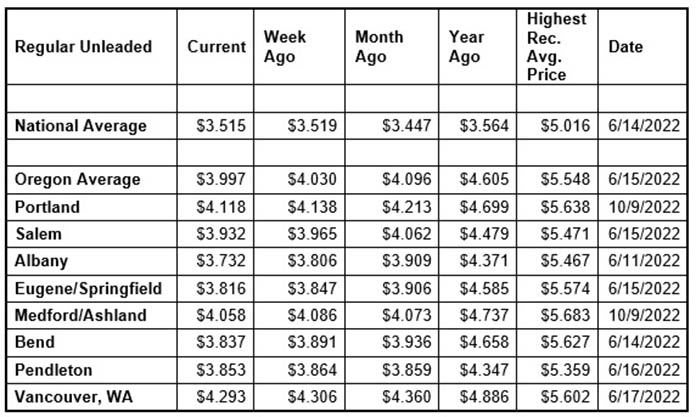The Oregon average for regular gas drops below $4 a gallon for the first time since March 14.
Pump prices are barely budging with almost all states seeing small gains or declines on the week. Driving this lull are sluggish demand for gas in the U.S. and crude oil prices that are stuck around $80 per barrel. For the week, the national average for regular slips half a cent to $3.52.
The Oregon average ticks down three cents to $3.997 a gallon.
“Gas prices will likely continue to see small fluctuations in the short-term, barring unforeseen events. Forecasters continue to predict an active hurricane season, and there’s the potential for surges in pump prices if a storm impacts drilling, refining and distribution in the Gulf Coast,” says Marie Dodds, public affairs director for AAA Oregon/Idaho. “Hurricane Beryl caused limited damage to energy facilities in the Gulf Coast so did not have a major impact on pump prices. However, thousands of people remain without power in Texas, and power outages mean gas stations are not able to operate unless they have backup generators.”
The national and Oregon averages are at the same prices as they were in March. This week, 20 Oregon counties have averages below $4 per gallon, compared to 16 counties a week ago:
- Baker $3.81
- Benton $3.68
- Crook $3.95
- Deschutes $3.81
- Douglas $3.86
- Gilliam $3.90
- Hood River $3.97
- Jefferson $3.80
- Klamath $3.98
- Lane $3.81
- Linn $3.72
- Lincoln $3.77
- Malheur $3.89
- Marion $3.92
- Morrow $3.85
- Polk $3.90
- Sherman $3.89
- Umatilla $3.84
- Yamhill $3.92
- Wasco $3.94
The Oregon average began 2024 at $3.79 a gallon compared to $3.997 today. Its lowest price so far this year is $3.58 on Feb. 14 and the highest is nearly $4.51 on May 1. The national average started the year at $3.11 and is at $3.52 today. Its lowest price so far this year is just under $3.07 on Jan. 15 and the highest is just under $3.68 on April 19.
Gas prices are often fairly steady during the summer months, barring hurricanes, supply disruptions and/or geo-political events. Gas prices always rise starting in late winter through the spring as refineries undergo maintenance as the switch to summer-blend fuel occurs. The switch occurs first in California, which is why pump prices on the West Coast often rise before other parts of the country. The East Coast is the last major market to make the change to summer-blend fuel. Most areas have a May 1 compliance date for refiners and terminals, while most gas stations have a June 1 deadline to switch to selling summer-blend until June 1. Switch-over dates are earlier in California with some areas in the state requiring summer-blend fuel by April 1. Some refineries will begin maintenance and the switchover as early as February.
Oregon is one of 27 states and the District of Columbia with lower prices now than a week ago. Colorado (-11 cents) has the largest week-over-week drop in the nation. Missouri (+7 cents) has the largest weekly increase. The averages in Iowa and Florida are flat.
California ($4.75) has the most expensive gas in the nation for the 20th week in a row. This is the sixth week in a row that the California average has been below $5 per gallon. Hawaii ($4.69) is second, Washington ($4.28) is third, and Nevada ($4.01) is fourth. These are the four states with averages at or above $4 a gallon, down from five states a week ago when Oregon still had an average above $4. This week 46 states and the District of Columbia have averages in the $3-range. There are no states with averages in the $2 range this week.
The cheapest gas in the nation is in Mississippi ($3.00) and Arkansas ($3.09). No state has had an average below $2 a gallon since January 7, 2021, when Mississippi and Texas were below that threshold.
The difference between the most expensive and least expensive states is $1.74 this week, compared to $1.79 a week ago.
Oregon is one of 11 states with lower prices now than a month ago. The national average is seven cents more and the Oregon average is 10 cents less than a month ago. This is the fourth-largest month-over-month decline in the nation. Florida (+23 cents) has the largest monthly gain in the nation. Arizona (-14 cents) has the largest month-over-month decrease.
Oregon is one of 33 states with lower prices now than a year ago. The national average is five cents less and the Oregon average is 61 cents less than a year ago. This is the second-largest year-over-year drop in the nation. Washington (-66 cents) has the largest yearly decrease. Georgia (+11 cents) has the largest year-over-year increase.










